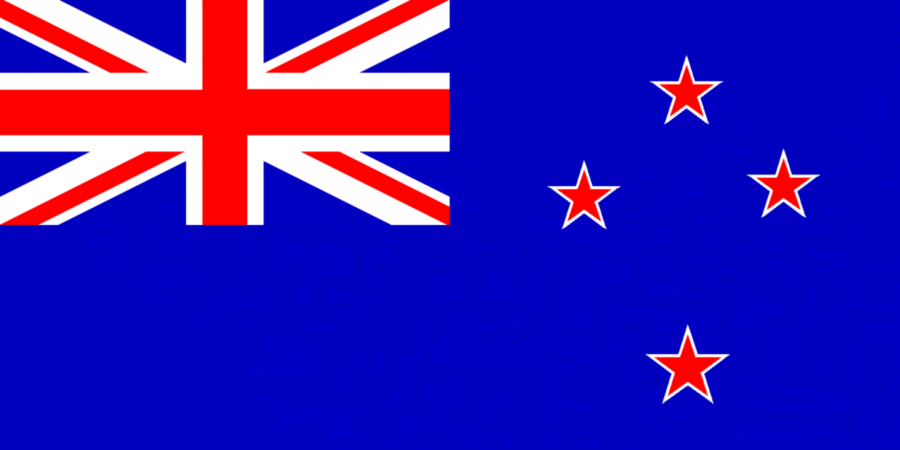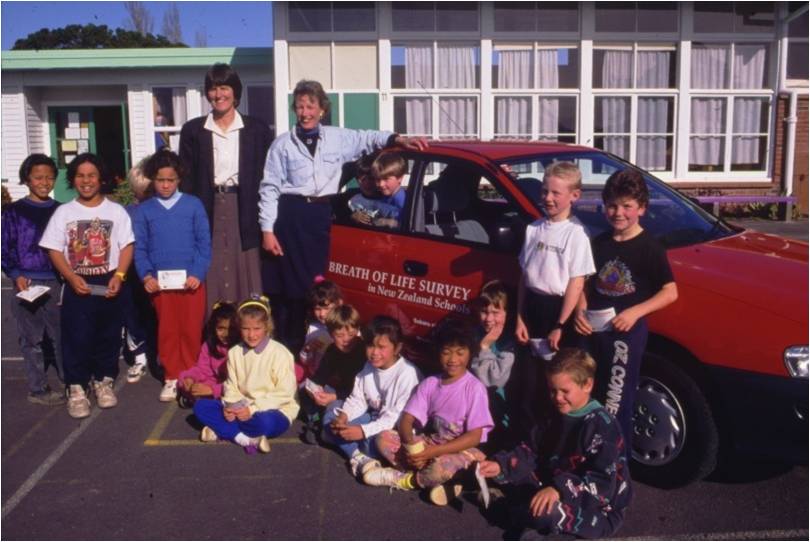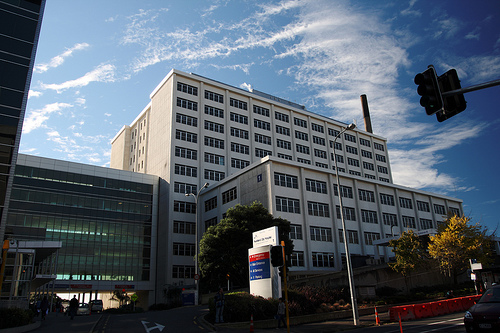
National Publications
The following publications used ISAAC data from New Zealand:
- Shaw RA, Crane J, Pearce N, et al. Comparison of a video questionnaire with the IUATLD written questionnaire for measuring asthma prevalence. Clin Exp Allergy 1992; 22(5): 561-568.
- Shaw R, Woodman K, Ayson M, Dibdin S, Winkelmann R, Crane J, Beasley R, Pearce N. Measuring the prevalence of bronchial hyper-responsiveness in children. Int J Epidemiol 1995; 24(3): 597-602.
- Stewart AW, Asher MI, Clayton TO, Crane J, D'Souza W, Ellwood PE, Ford RPK, Mitchell EA, Pattemore PK, Pearce N. The effect of season-of-response to ISAAC questions about asthma, rhinitis and eczema in children. Int J Epidemiol 1997; 26: 126-36.
- Asher MI, Barry D, Clayton T, Crane J, D'Souza W, Ellwood P, Ford RPK, Mackay R, Mitchell EA, Moyes C, Pattemore P, Pearce N, Stewart AW. The burden of symptoms of asthma, allergic rhinoconjunctivitis and atopic eczema in children and adolescents in 6 New Zealand centres: ISAAC Phase One. NZ Med J 2001; 114: 114-20.
- Pattemore PK, Ellison-Loschmann L, Asher MI, Barry DMJ, Clayton TO, Crane J, D'Souza WJ, Ellwood P, Ford RPK, Mackay RJ, Mitchell EA, Moyes C, Pearce N, Stewart AW. Asthma prevalence in European, Maori, and Pacific children in New Zealand: ISAAC study. Pediatr Pulmonol 2004; 37(5): 433-42.
- Erwin EA, Wickens K, Custis NJ, Siebers R, Woodfolk J, Barry D, Crane J, Platts-Mills TA. Cat and dust mite sensitivity and tolerance in relation to wheezing among children raised with high exposure to both allergens. J Allergy Clin Immunol 2005; 115(1): 74-9.
- Asher MI, Stewart AW, Clayton T, Crane J, Ellwood P, MacKay R, Mitchell E, Moyes C, Pattemore PK, Pearce N. Has the prevalence and severity of symptoms of asthma changed among children in New Zealand? ISAAC Phase Three. NZ Med J 2008; 121(1284): 52-63
- Ellison-Loschmann L, Pattemore PK, Asher MI, Clayton TO, Crane J, Ellwood P, Mackay RJ, Mitchell EA, Moyes C, Pearce N, Stewart AW. Ethnic differences in time trends in asthma prevalence in New Zealand: ISAAC Phases I and III. Int J Tuberc Lung Dis 2009; 13(6):775-782.
- Mitchell EA, Stewart AW, Clayton TO, Asher MI, Ellwood P, Mackay R, Moyes C, Pattemore PK, Pearce N. Cross-sectional survey of risk factors for asthma in 6–7-year-old children in New Zealand: International Study of Asthma and Allergy in Childhood Phase Three. J Paediatr Ch Health 2009 June; 45(6): 375–383.
- Moyes CD, Clayton T, Pearce N, Asher MI, Ellwood P, Mackay R, Mitchell E, Pattemore P, Stewart AW, Crane J. Time trends and risk factors for rhinoconjunctivitis in New Zealand children: An International Study of Asthma and Allergies in Childhood (ISAAC) survey. J Paediatr Child Health. 2012;48(10):913-20. doi: 10.1111/j.1440-1754.2012.02518.x. Epub 2012 Aug 17.
- Clayton T, Asher MI, Crane J, Ellwood P, Mackay R, Mitchell EA, Moyes CD, Pattemore P, Pearce N, Stewart AW. Time trends, ethnicity and risk factors for eczema in New Zealand children: ISAAC Phase Three Asia Pac Allergy 2013;3(3):161-178
New Zealand, Oceania
| Centres: | Phase: | PI: | Age Groups |
|---|---|---|---|
| Auckland | 1 | Professor M Innes Asher ONZM | 13-14, 6-7 |
| Bay of Plenty | 1 | Dr Chris Moyes | 13-14, 6-7 |
| Christchurch | 1 | Associate Professor Philip Pattemore | 13-14, 6-7 |
| Hawkes Bay | 1 | Dr David Barry | 13-14, 6-7 |
| Nelson | 1 | Dr Richard MacKay | 13-14, 6-7 |
| Wellington | 1 | Professor Julian Crane | 13-14, 6-7 |
| Hawkes Bay | 2 | Professor Julian Crane | 10.1-12.6 years |
| Auckland | 3 | Professor M Innes Asher ONZM | 13-14, 6-7 |
| Bay of Plenty | 3 | Dr Chris Moyes | 13-14, 6-7 |
| Christchurch | 3 | Associate Professor Philip Pattemore | 13-14, 6-7 |
| Nelson | 3 | Dr Richard MacKay | 13-14, 6-7 |
| Wellington | 3 | Professor Neil Pearce | 13-14, 6-7 |
National Coordinator:
Roles:
- Chairperson of the ISAAC Steering Committee
- Chairperson of the ISAAC Executive
- Director, ISAAC International Data Centre
- National Coordinator for New Zealand
Professor Asher is head of the Department of Paediatrics: Child and Youth Health at the University of Auckland and a Consultant Paediatrician at the Starship Children's Hospital, Auckland. Professor Asher's current research interests include asthma epidemiology, bronchiectasis, inhaler devices and poverty and child health.
Professor Innes Asher

Department of Paediatrics: Child and Youth Health
Faculty of Medical and Health Sciences
The University of Auckland
Private Bag 92019
New Zealand
Why was New Zealand selected for ISAAC?
New Zealand started focusing on asthma in earnest in 1981 when it became apparent that a new epidemic of asthma deaths had arisen in 1977, affecting New Zealand more than any other country. This stimulated a range of research programmes exploring the reasons for this epidemic, starting with a prospective national asthma mortality study which confirmed the presence of an epidemic of asthma deaths. A focus on the number of admissions to hospital for asthma found that there were dramatic increases in New Zealand, Australia, The United Kingdom, Canada and USA and the highest number of admissions per capita was in New Zealand children.
In the 1980s in New Zealand there were several studies of asthma prevalence which showed a high and rising prevalence of asthma in school aged children. The 1985 Auckland asthma prevalence study of 7-10 year old children was able to explore potential reasons for differences in mortality and hospital admissions between NZ and Australia, and between European, Māori and Pacific children in Auckland. For the first time anywhere in the world, this study used the same protocol (questionnaire and histamine challenge) to compare asthma in two different countries. Current wheezing was very similar in Auckland European children (14.8%) and Wagga Wagga, inland NSW (15%) and slightly lower in Belmont, coastal NSW (10%), and these changes were paralleled very closely in the BHR prevalences (20.2%, 19.1%, 15.5% respectively). Within the Auckland sample, we found that Māori children had the highest prevalence of respiratory symptoms, and Europeans had rates similar to Pacific children. The prevalence of diagnosed asthma was similar between the three ethnic groups, whereas bronchial hyperresponsiveness to histamine, unlike the Auckland-NSW comparisons, did not parallel the symptom prevalences. Bronchial hyperresponsiveness among Europeans was 20%, Māori 13% and Pacific children 8.7%. As a result of this study it seemed that the symptoms more clearly paralleled the hospital admission and mortality data than did bronchial hyperresponsiveness, and the questionnaire used in this study therefore set the pattern for future studies.
In 1991 we received a grant from the Health Research Council of New Zealand to compare the prevalence and severity of childhood asthma in two age-groups of children both between countries and within New Zealand (by area and ethnic group). This HRC grant covered the costs of fieldwork in Auckland, Wellington and Christchurch, and in Auckland a full-time data manager, and secretarial and computing support. The funding remained conditional upon at least one other centre outside New Zealand obtaining funds for a similar survey in their own centre, a requirement which was soon met. This initiative joined with the German initiative (see ‘Origins’) in March 1991, which then formally became ISAAC.
Our experience of ISAAC
Phase One:
Six centres took part in both age groups in 1992-3: Auckland, Bay of Plenty, Christchurch, Hawkes Bay, Nelson, Wellington [Asher 2001]. We found that asthma, rhinitis and eczema symptoms were common in New Zealand school children with resultant morbidity and cost. The prevalence of symptoms was high, for asthma 25% and 30%, allergic rhinoconjunctivitis 10% and 19%, and atopic eczema 15% and 13% in the 6-7 year (children) and 13-14 year (adolescent) age groups respectively. More than 40% of participants had symptoms in the last year of at least one condition, most commonly asthma. There was little regional variation with the exception of lower rates in Nelson children who had significantly lower prevalence values for some symptoms of asthma and allergic rhinoconjunctivitis.
Season of response
In New Zealand we chose to examine whether the season in which the parent/adolescent responded to the questionnaire influenced the symptom prevalence of asthma. Auckland, Wellington and Christchuch were the three New Zealand centres where this was examined. The resultant publication [Stewart 1997] showed that there was no effect for eczema symptoms, a small effect for asthma symptoms, and a significant season-of-response effect for rhinitis symptoms.
Ethnic comparisons Phase One
We had sufficient numbers of participants to undertake a comparison based on ethnicity [Pattemore 2004]. Māori children had higher rates of diagnosed asthma and reported asthma symptoms than Pacific participants in both age groups (diagnosed asthma in 6-7-year-olds: Māori, 31.7%; Pacific, 21.2%; 13-14-year-olds: Māori, 24.7%; Pacific, 19.2%; recent wheeze in 6-7-year-olds: Māori, 27.6%; Pacific, 22.0%; 13-14-year-olds: Māori, 30.8%; Pacific, 21.1%). European children had rates intermediate between those of Māori and Pacific children (6-7-year-olds) or similar to those of Māori participants (13-14-year-olds), but had the lowest prevalence of night waking with wheeze in both age groups. The pattern of differences closely resembled that in the 1985 Auckland study, despite a 1.5–1.7-fold overall increase in prevalence between 1985 and 1992-3. Thus there are important differences in asthma prevalence among Māori, Pacific, and European children and adolescents. These differences are small compared to worldwide variation, but the pattern is stable over time. The higher rate of severe asthma symptoms that Māori and Pacific children and adolescents report may be one reason for the increased asthma morbidity in these groups.
Phase Two:
One centre took part in Phase Two: Hawke’s Bay. We chose to undertake ISAAC Phase Two study in Hawke’s Bay because it gave us an opportunity to undertake two studies using largely a single set of fieldwork, to provide data for ISAAC Phase Two and secondly we were able to use much of the same data to provide to repeat one of the first international asthma prevalence surveys that had been undertaken by Michael Burr and David Barry in the Hawke’s Bay and Wales[Barry 1991], and later included South Africa and Sweden[Burr 1994], using the same schools, methodology and personnel to give us a comparison of prevalence over a 10 year period.
The study was run by Dr Kristin Wickens in the Hawkes Bay over the summer period 2000. We had excellent help from Dr Barry himself and also from one of his retired senior paediatric nurses – Ms Ngaire Bone. We were also fortunate to have two third year medical students join us from the Netherlands looking for a small student elective to undertake research and they provided excellent additional support for the field work and also got a publication from an add on project undertaking during the fieldwork[Rhodius 2002]. The study provided New Zealand data for ISAAC Phase Two, but also provided a number of spin-off studies that looked at fast foods and asthma and changes in obesity and their relationship to asthma over 10 years[Wickens 2005(1), Wickens 2005(2)]. The data also formed the basis for some interesting work on cat allergen[Erwin 2005] undertaken by Tom Platt-Mills and colleagues who also measured spIgE levels for the study.
The Hawkes Bay turned out to be an excellent place to undertake research like this and we had tremendous co-operation from the schools and from the surrounding community and also had enormous benefit from employing people who were well known in the community and were able to encourage both schools and parents to take part.
Also we undertook two forms of measurement of airway hyperresponsiveness, exercise and hypertonic saline. The exercise challenge used a five minute running test[Burr 1989] allowing us to compare this challenge with previous studies and with the UK centre which also used it. We also undertook a hypertonic saline challenge and again were fortunate to have a visiting research fellow to help us with this.
In this 8 to 12 age group we found the prevalence of wheezing in the last year was 22.0% and asthma ever, 35.7%. A positive exercise challenge (≥15% fall in PEFR post exercise) was found in 8.4%. A positive skin prick test to any allergen was found in 34.7% of children. Interestingly when comparing the prevalence from 10 years before (restricted to just the 12 year old children) wheezing had increased from 17.7% to 23.3%, asthma ever from 16.9% to 37%, while a positive exercise response had fallen from 12.3% to 9.0%.
Phase Three:
Five centres took part in Phase Three in both age groups 9 years after their participation in Phase One [Asher 2008]: Auckland, Bay of Plenty, Christchurch, Nelson and Wellington. The low response rate for children within Wellington meant that centre was excluded for the younger age group. Reported asthma ever increased from 24.6% to 30.2% in children and from 24.1% to 32.4% in adolescents. Current wheeze (written questionnaire) significantly decreased in children from 23.6% to 22.2% and in adolescents from 29.7% to 26.7%, and for the video questionnaire from 18.1% to 11.1% (p<0.001). There was a significant reduction in wheezing limiting speech from 5.0% to 3.7% in children, and 7.9% to 6.2% in adolescents. Little regional variation was found; the lower prevalence for some symptoms reported for Nelson in Phase One was not evident for Phase Three. A higher proportion of participants with asthma symptoms in Phase Three reported having ever had asthma compared with Phase One. The decrease in prevalence and severity of symptoms of asthma was encouraging, but the reasons for these trends are currently unclear. Increases in asthma labelling are likely to be due to greater awareness of asthma. A trend of decreasing prevalence of asthma symptoms, if maintained, has positive implications for lessened burden of disease among asthmatics and lowered cost of treatment.
Ethnic comparisons Phase Three
Ethnic disparities were examined again, the first international report of time trends in ethnicity [Ellison-Loschmann 2009]. The prevalence of current wheeze in children was 28.5% in Māori and 25.2% in Pacific, compared with 20.7% in European/Pakeha. In adolescents, 29.9% of Māori and 20.8% of Pacific experienced current wheeze, compared to 28.6% of European/Pakeha. Between Phases One and Three, the prevalence of current wheeze increased significantly by 0.49% per year in Pacific children, increased non-significantly by 0.12% per year in Māori children, and decreased significantly by 0.25% per year in European/Pakeha children. Among adolescents, the prevalence of current wheeze increased by 0.05% per year in Pacific. In contrast, European/Pakeha and Māori adolescents showed decreases of 0.33% per year and by 0.07%per year respectively. Ethnic differences in asthma symptom prevalence in New Zealand have thus increased between Phase One and Phase Three. The reasons for this are unclear, but may reflect inequalities in access to health services.
Risk factor analyses
Risk factor analyses are being undertaken for each of the three diseases. As for the worldwide analyses, antibiotics and paracetamol used in the first year of life were associated with an increased risk of current wheeze. Watching television for 5 or more hours per day was associated with an increased risk of current wheeze, whereas consumption of milk and eggs consumption in the last 12 months was associated with a reduced risk of current wheeze.
Impact of ISAAC
ISAAC has provided vital information concerning prevalence and time trends of asthma, rhinitis and eczema within New Zealand, as well as providing a global context. We presumed that prevalence in New Zealand was high compared with many other countries but this could only be confirmed by a unique international study such as ISAAC. Ethnic disparities in asthma within New Zealand have been confirmed, and the widening gap for Māori could be preventable. ISAAC has also promoted development of research links within New Zealand, and with international collaborators, and has provided New Zealand researchers with invaluable experience of playing a leading role in a large international collaborative research programme.
Acknowledgements
We gratefully acknowledge financial support from the Health Research Council of New Zealand, the Asthma and Respiratory Foundation of New Zealand, the Child Health Research Foundation, the Hawke’s Bay Medical Research Foundation, the Waikato Medical Research Foundation, Glaxo Wellcome New Zealand, Nelson Marlborough Health Services Ltd, the NZ Lottery Board and Astra Zeneca New Zealand. We are also indebted to all the children, parents and school staff who participated in the surveys, and wish to thank our fieldwork teams for their enthusiasm and diligence throughout each study.




